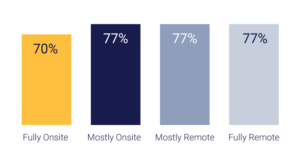The recent pandemic forced many employees into remote work settings. Although the shift was initially abrupt and challenging, countless companies and employees found value in their new remote work models. So much value that remote and hybrid work models have now become an expected perk. It may even help companies to attract talent.
It seems hybrid work models have had a positive impact on employee engagement. In a study of more than 2 million employees across 17 different industries, Top Workplaces research shows a clear link between work flexibility and employee engagement, shown here:
Employee engagement: Onsite vs. remote and hybrid employees

What are hybrid work models?
As the term suggests, hybrid work models involve a combination of remote work and on-site work. The arrangement allows employees to choose where and how they work.
In a hybrid work model, employees can work from the office and from home, depending on what suits them and their tasks best. It’s about balancing and creating a work environment that promotes workplace flexibility. Employees can visit the office for collaborative meetings, team-building activities, or face-to-face interaction. On the other hand, they are also free to work offsite when they need to focus, avoid commuting, or juggle personal commitments.
Here’s the difference between hybrid and remote work models: Remote work typically implies employees primarily work from outside the office, often from their homes or other locations. Hybrid work combines remote work with the option to work from a physical office, creating a more dynamic and adaptable setup. To some, hybrid work models offer the best of both worlds.
The different types of hybrid work
If you’re an HR professional looking to improve hybrid flexibility in your workplace, there are many types of hybrid work models to consider. The most common types of hybrid work models are:
- Office-first hybrid work models
- Flexible hybrid work models
- Team-designated hybrid work models
- Remote-first hybrid work models
- Split-week hybrid work models
- Week-by-week hybrid work models
To find the right fit, employees and employers must be on the same page and open to honest communication. Pay attention to what’s working, what’s not, and don’t be afraid to test new things.
1. Office-first hybrid work model
Out of all the hybrid work models, an office-first approach is most reminiscent of pre-pandemic work. This model requires employees to work most of their hours from the office.
Pros
- Higher levels of interdepartmental collaboration and teamwork
- More efficient communication
- Increased innovation and inspiration from in-person meetings
- Improved employee socialization
- Physical connection to workplace community and culture
Cons
There can be disadvantages and challenges with this type of hybrid work model, including:
- Increased sick days and paid time off
- Not necessary for low-collaboration and self-managed roles
- Higher commute costs and longer commute times
- Employee dissatisfaction when employees want workplace flexibility and don’t receive it
2. Flexible hybrid work model
Next on the list is a flexible hybrid work model. This type of hybrid work is the opposite of the office-first model we just covered. Instead, employees decide which days to work remotely and onsite.
Pros
Benefits of flexible hybrid work models include:
- Improved employee trust and autonomy
- Increased employee well-being and morale
- Improved recruitment and job-seeker interest
- Reduced commuting costs (money and time)
- Higher levels of employee engagement
Cons
Some possible disadvantages of flexible hybrid work models include:
- Decreased performance or missed goals
- Underutilization of office spaces
- Increase in team silos
3. Team-designated hybrid work model
When organizations have certain teams that need to be in-person and others that prefer to work offsite, a team-designated hybrid work model might be the answer. In this model, leadership determines the workplace flexibility expectations for everyone on a team-by-team basis.
Pros
There are quite a few benefits of team-designated hybrid work models:
- Improved efficiency and productivity communication
- Reduced commuting and labor costs
- Self-management opportunities for employees and managers
- Increased acceptance of different working methods
Cons
But there are also quite a few challenges that come with this model:
- Disconnect between in-person and remote employees
- Wide range of required employee benefits and management styles
- Increased rifts between teams
- Requires more intentional communication from senior leaders
4. Remote-first hybrid work model
Remote-first hybrid work models mean all employees work remotely most of the time. Under this model, organizations often have an in-person location available for the occasional team meeting, client event, or day in the office.
Pros
As previously mentioned, there are many benefits of remote work, including:
- Reduced overhead costs
- Increased employee and employer trust
- Boosted well-being and work-life flexibility
- Streamlined employee benefits and expectations
- Increased talent pool from a wider range of locations
- Improved employee recruitment and job-seeker interest
Cons
There can also be some risks, such as:
- Reduced communication, both across and within teams
- Increased miscommunication and silos
- Harder to maintain remote employee engagement
- Higher levels of employee work burnout and quiet quitting
5. Split-week hybrid work model
Next on the list? Split-week hybrid work models. After getting employee feedback about workplace opinions and preferences, managers and leaders assign on-site and remote work days for each team. This model works best when everyone is on the same page and feels heard.
Pros
Because this model is a bit of a “choose-your-own-adventure” situation, there is a range of benefits:
- Allows space for experimentation and open communication
- Avoids overcrowding and empty offices
- Improved communication and feedback opportunities
- Higher levels of flexibility during times of uncertainty
Cons
- Certain teams may never be in the office at the same time
- Increased operational and overhead costs
- Requires consistency across teams
- Higher commuting costs (time and money)
6. Week-by-week hybrid work model
If you couldn’t tell already, choosing a hybrid work model is about finding what works best for your employees and organization. In this last model, leaders decide which weeks employees need to be in-person and which weeks employees can work remotely. This option ensures that people are always in the office, even if it’s only a handful of teams at a time.
Pros
Here are the pros of a week-by-week hybrid model:
- Ability to downsize office location
- Reduced overhead and commuting costs
- Helpful for large organizations
- Improved future planning and predictability
- Consistent team meetings and goal setting
Cons
And finally, here are the cons of this type of hybrid work model:
- Silos across and within teams
- Self-managed roles might find the in-person weeks unproductive
- Not helpful for unplanned events or meetings
Measuring employee engagement for hybrid employees
No matter which type of hybrid work model you choose, keeping employees engaged in their work is crucial. The best hybrid work model for your organization is the one that promotes engagement, drives productivity, and retains top talent. One of the most accurate ways to measure the employee experience and engagement is a trusted survey.
Learn more: Improve Employee Engagement with Top Workplaces
Identify the key drivers of engagement for your employees and hear what employees say about your work model.
Nominate your organization for Top Workplaces, the employee feedback-driven recognition program that offers awards in 60+ regional markets and national awards for culture and industry excellence.

 Stand out with an award-winning
Stand out with an award-winning